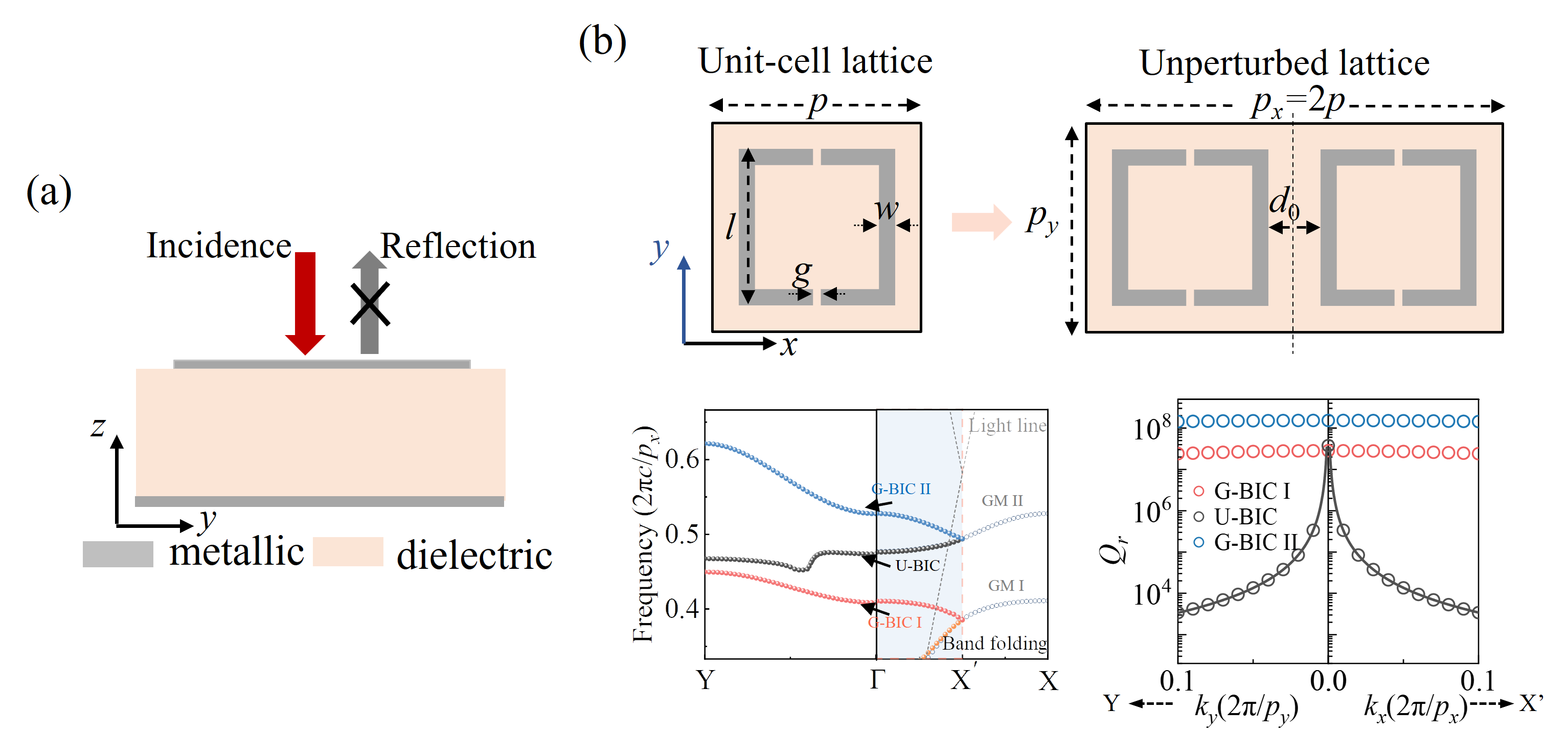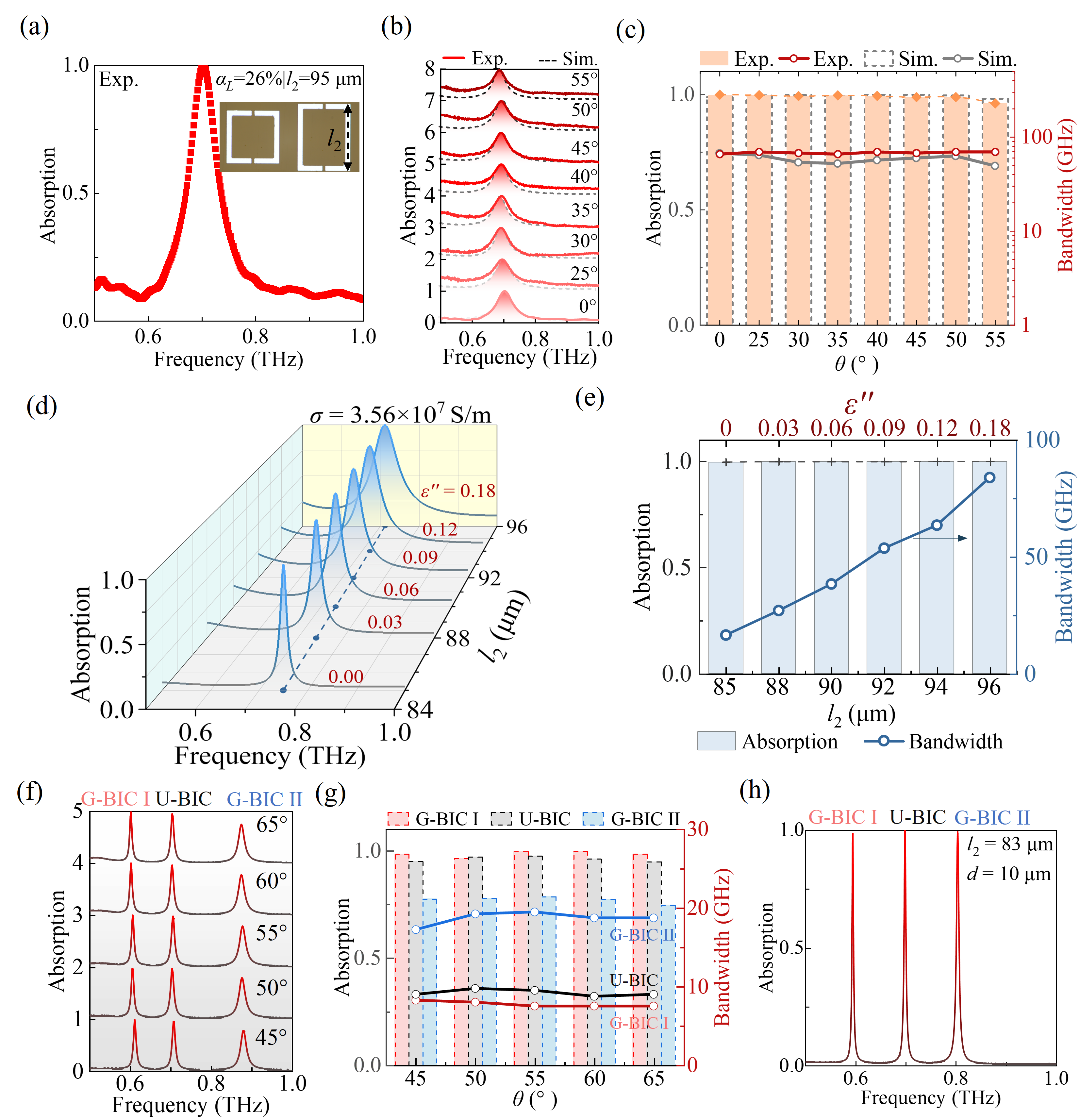High-performance terahertz absorbers are crucial for terahertz techniques in secure communication, radar stealth, sensing, and imaging. However, natural materials often struggle to simultaneously meet the practical demands for stable high absorption, wide field of view, controllable bandwidth, and flexibility. It has been a pressing task to find solutions for absorbers that can address these requirements for practical usage. Metasurfaces offer a new approach to probing the mechanisms of accessing an ideal absorber by precisely tailoring the geometries. According to temporal coupled-mode theory (CMT), a metasurface-based perfect absorber can be achieved by balancing radiative and nonradiative losses. Thus, interpreting mode properties and tailoring systematic losses are key to improving absorption performance.
Bound states in the continuum (BICs) exhibit zero radiative loss but can transition to quasi-BICs (QBICs) with a controllable radiative loss by introducing structural asymmetry. This mechanism has been widely adopted to boost light-matter interactions in applications such as lasers, modulators, nonlinear optics, and quantum photonics. Recent research on BICs has focused on the exploration of their radiative and topological properties in momentum space, primarily by precisely tailoring the geometric parameters of the resonator itself. As an additional degree of freedom, lattice dimensions provide a flexible channel to tune BICs and alleviate the rigid requirements of geometric parameters.

A research team led by Associate Professor Longqing Cong from the Department of Electronic and Electrical Engineering at the Southern University of Science and Technology (SUSTech), in collaboration with other researchers, has recently developed a novel flexible terahertz metasurface absorber empowered by BICs. This study connects the unique radiation characteristics of symmetry-breaking BICs with absorber performance. By combining temporal coupled-mode theory, the team demonstrated stable absorption over a large field of view, tunable bandwidth, and multi-band absorption in the proposed device.
Their work, entitled “Flexible Terahertz Metasurface Absorbers Empowered by Bound States in the Continuum”, has been published in Advanced Materials.
Unlike the traditional approach of breaking the symmetry of the resonator itself, the team innovatively explored the radiation properties of BICs from the perspective of lattice symmetry. They designed the absorber using a typical metal-insulator-metal (MIM) configuration to construct a single-port resonator system (Figure 1(a)). By incorporating the classical double split-ring resonator (DSRR) to form a unit cell, they introduced different types of lattice periodic perturbations in a square lattice, resulting in additional band-folding BICs (Figure 1(b)). The radiation characteristics of these BICs were systematically investigated through band theory, multipolar, and topological analysis. By leveraging the flexible radiation characteristics of lattice-perturbed BICs, they utilized CMT to specifically address the tunability of absorption bandwidth, wide field of view, and multi-band absorption in the proposed device.

Figure 1. Schematic of MIM metasurface absorber and mechanism of lattice-perturbed BICs.
The researchers fabricated the flexible terahertz metasurface absorber using an MIM-configuration on a polyimide (PI) film substrate and measured the angle-resolved reflection spectra using a terahertz time-domain spectroscopy system. The experimental results aligned closely with simulations, confirming the stable radiation characteristics of lattice-perturbed BICs across various incident angles in momentum space. The study also highlighted the independent control capabilities of two types of lattice-perturbed BICs under different lattice perturbations in parameter space (Figure 2). These distinct radiation properties of BICs provided valuable theoretical insights for customizing the performance of terahertz absorbers.

Figure 2. Demonstration of mode properties in simulations and experiments in geometric parameter space.
Based on the comprehensive investigation of BICs radiation characteristics, this study showcases the ability to customize terahertz absorber performance in different scenarios. The researchers successfully demonstrated nearly perfect absorption with stable bandwidth across a wide field of view covering ±55° (Figure 3(a-c)), significantly enhancing the absorber’s practicality for potential applications in energy harvesting and radar stealth. By adjusting the material’s intrinsic absorption loss and leveraging the controllable radiative loss of lattice-perturbed BICs, perfect absorption with bandwidth coverage ranging from 16 GHz to 84 GHz was achieved (Figure 3(d-e)). Furthermore, through the band-folding process, multi-band perfect absorption within the desired frequency range was observed (Figure 3(f-h)). This approach not only alleviates fabrication complexity but also offers precise control over device absorption properties, providing an effective strategy for ultra-broadband multispectral sensing applications.

Figure 3. Performance of flexible terahertz metasurface absorbers: (a-c) perfect absorption over a wide field of view; (d-e) perfect absorption with tunable bandwidth; (f-h) multi-band perfect absorption.
In summary, this research explores the radiation characteristics of BICs within the framework of lattice symmetry, resulting in the development of a flexible terahertz metasurface absorber with key features like stable high absorption over a wide field of view, tunable bandwidth, and multi-band absorption. This innovative and flexible design offers a comprehensive solution for high-performance terahertz absorbers and holds promise for applications in wearable devices, stealth technology, and multispectral sensing. These findings enrich the theoretical understanding of BICs and provide valuable insights for the development of metasurface optoelectronic devices and terahertz photonics.
Ph.D. student Guizhen Xu from the Department of Electronic and Electrical Engineering at SUSTech is the first author of the paper. Associate Professor Longqing Cong and Associate Professor Ye Zhou from Shanghai Jiao Tong University are the co-corresponding authors, with SUSTech serving as the first affiliated institution. Chair Professor Perry Ping Shum from SUSTech also contributed to the study.
This work was supported by the National Natural Science Foundation of China, Guangdong Basic and Applied Basic Research Foundation, Shenzhen Science and Technology Program. The researchers also acknowledge the assistance of the SUSTech Core Research Facilities for their technical support.
Paper link: https://onlinelibrary.wiley.com/doi/10.1002/adma.202406526
To read all stories about SUSTech science, subscribe to the monthly SUSTech Newsletter.
Proofread ByAdrian Cremin, Yingying XIA
Photo ByDepartment of Electronic and Electrical Engineering